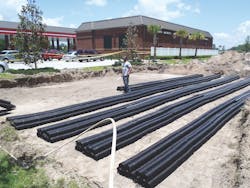About the author:
Steve Cooper is a writer for SCA Communications. Cooper can be reached at [email protected].
A RaceTrac gas station and convenience store in Central Florida was plagued with rising maintenance costs due to a problematic aerobic wastewater system and an associated failed drain field.
The company’s engineers determined a retrofit of the store’s existing wastewater tanks with pumps and conversion to a pressure-dosed system was in order. Selection of the low profile “rockless” drain field system available from Advanced Drainage Systems Inc. (ADS) met all the required project criteria. Made up of perforated 4-in.-diameter high-density polyethylene (HDPE) corrugated pipe with both holes and slots, it can take the place of a conventional gravel system while providing more capacity and can be installed with shallow cover. With a project life expectancy of more than 30 years, the new system is rated at 10.9 gal per ft, whereas a traditional 4-in. pipe-in-gravel system of the same size could handle 7.9 gal per ft.
By using Void pipe, gravel was no longer needed as cover. Instead, 6 in. of native sandy soil was used.
Plotting the Pipes
“Drain fields date back to the times of the early Romans when they would use clay tiles buried underground to disperse effluent for their sanitary needs,” said Tony Radoszewski, CAE, president of the Plastics Pipe Institute Inc. (PPI), a North American trade association representing all segments of the plastic pipe industry. “Then came the conventional gravel system and, later, HDPE corrugated pipe, which added storage capacity for the effluent to be held until the soil could accept it.
“The use of HDPE pipe for sanitary installations has many benefits,” he continued. “The first applications were in Scandinavian countries and in Germany during the mid-sixties. An independent testing agency examined the systems and reported that no significant changes in the pipes’ chemical or physical properties after more than 25 years in service existed. Sanitary sewage is itself not highly corrosive, but under anaerobic conditions, bacteria may decompose sanitary sewage and form hydrogen sulfide gas. The gas combines with moist air above the fluid stream and creates sulfuric acid, which then attacks metallic or concrete pipe but has no effect on polyethylene pipe. HDPE pipe is highly resistant to the wet, hydrogen sulfide gas and the low concentrations of sulfuric acid found in a sanitary sewer. For example, this type of pipe is resistant to 90% sulfuric acid solution at service temperatures up to 120°F, so it’s a perfect product to use in this installation.”
At the store, the 1,200-sq-ft system involved eight 50-ft runs of 4-in.-diameter HDPE distribution pipe nestled between two bundles of Void pipe. The Void pipes are specially manufactured by ADS, a member company of PPI, with both holes and slots to allow for the passage of the effluent, allowing for evaporation and transpiration. Over time, grease would bridge slots and holes would clog. HDPE pipe alleviates both of these issues.
The distribution pipe, marked with a white line, is the only one to be connected to the outflow of the tank. A 1-in.-diameter PVC pressure-dosed pipe was fed through HDPE endcaps on the distribution pipe. The cover was 6 in. of native, sandy soil.
“Flanking the HDPE corrugated distribution pipe with bundles of the Void pipe eliminates the need for gravel,” said Daniel Currence, P.E., director of engineering for the corrugated plastic pipe division of PPI. “Since standard HDPE plastic fittings can be made to fit SDR fittings, a PVC inspection port/riser could easily be constructed to ground level within each 4-in. HDPE distribution pipe. The riser provides the ability to monitor the performance of each dosed pipe and check the drain field level in each run. Since the dosing pipe rests unattached within the HDPE distribution pipe, it can be serviced if needed without having to dig up the whole run by simply removing the HDPE endcaps to restore a plugged line.”
John Johnson, owner of Acme Environmental Services in Mims, Fla., accomplished the installation in just a few hours.
About the Author
Steve Cooper
Steve Cooper is a writer for SCA Communications. Cooper can be reached at [email protected].

